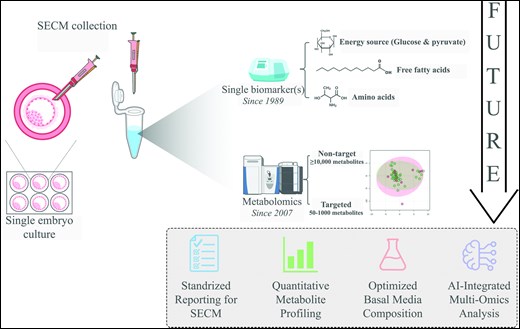Abstract
Single embryo transfer is globally recommended during IVF treatments. Hence, there is a growing demand for better embryo selection. Additionally, to morphology and genetics, nutrient uptake/release and metabolome profiles in spent embryo culture media (SECM) are proposed as non-invasive biomarkers. Are they ready to be applied for clinical purposes?
OBJECTIVE AND RATIONALE
We reviewed methods of metabolism analysis for embryos, focusing on human SECM.
SEARCH METHODS
Until November 2024, the Cochrane Library, PubMed, and Google Scholar were surfed for peer-reviewed English-language studies in the human, with MeSH terms and keywords: ART, IVF, ICSI, aneuploidy, embryo transfer, embryo selection, culture media, metabolome, metabolomics, metabolic profile, artificial intelligence (AI), nutrients, carbohydrates, glucose, pyruvate, lactate, amino acids (AAs), fatty acids (FAs), and spent embryo culture medium (SECM). Also, the reference lists of all relevant articles were searched.
OUTCOMES
Forty-nine original publications (1989–2024) were found in which SECM samples were collected from 20 countries, focusing on preimplantation embryo metabolism single biomarker(s) of energy sources (glucose and pyruvate), AAs and free FAs (17 studies), or metabolomic analysis (32 studies). Focal points were blastocyst development, aneuploidy, embryo sex prediction, implantation, and pregnancy outcome. Eleven major companies, which supply embryo culture media, dominate the market. Nutrient composition of their culture media presents major challenges because they are not normally disclosed. In single-biomarker(s) studies, eight studies focus on glucose and pyruvate, eight on AAs, both alone and in combination with glucose or pyruvate, and their ratios. Since the absolute quantities of some AAs or glucose levels were reported in some studies, they all have the potential to become future biomarkers for clinical application. In metabolomics studies, almost all studies reported qualitative results, such as decrease/increase or the metabolite ratios. For absolute concentrations, the basal concentrations of the culture media must be considered. In sum, all differences in the experimental design, the platforms, and the results were analyzed.
WIDER IMPLICATIONS
Establishing a unified guideline for the reporting of metabolomics studies and a specific guideline outlining the minimum information required for SECM experiment publication will ensure that future studies provide all necessary and critical information. The metabolomics studies primarily focused on implantation and pregnancy, whereas we, as a first step, preferred multi-omics studies on absolute concentrations of metabolites of good vs poor quality and euploid vs aneuploid embryos. Following this step, these quantitative approaches might lead to more convincing successes. If small numbers of predictive biomarkers were identified, a simple, rapid, and cheap test could be developed for each medium, clinically performed in the fertility center. Furthermore, further research on basal media ingredients is needed, combined with targeted metabolomics. The future could be an integration of all—primarily non-invasive—information, omics, and other, by AI.
REGISTRATION NUMBER
The review protocol is registered on the OSF platform: https://osf.io/mxtbg

Graphical Abstract
Embryo selection based on spent embryo culture media (SECM) metabolite composition can be standardized through biomarker(s) selection, combined with analysis by artificial intelligence (AI).
